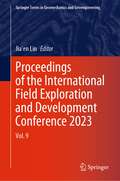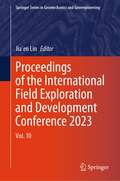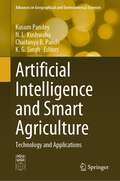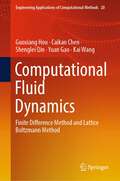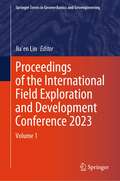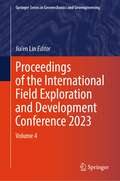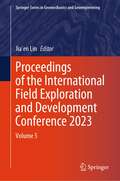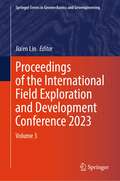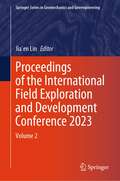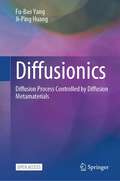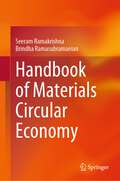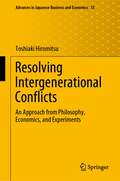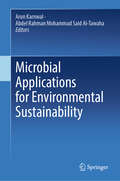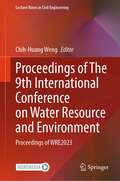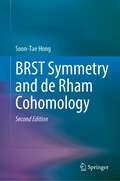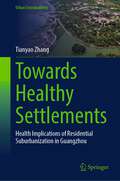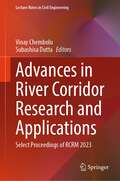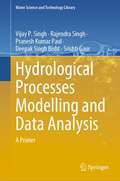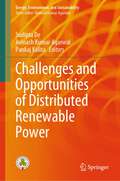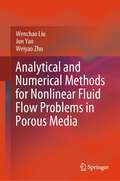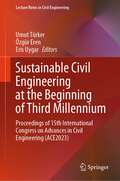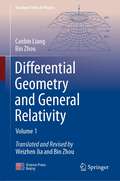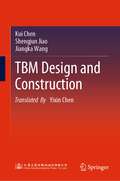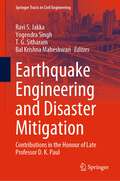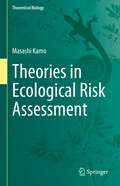- Table View
- List View
Proceedings of the International Field Exploration and Development Conference 2023: Vol. 9 (Springer Series in Geomechanics and Geoengineering)
by Jia'En LinThis book focuses on reservoir surveillance and management, reservoir evaluation and dynamic description, reservoir production stimulation and EOR, ultra-tight reservoir, unconventional oil and gas resources technology, oil and gas well production testing, and geomechanics. This book is a compilation of selected papers from the 13th International Field Exploration and Development Conference (IFEDC 2023).The conference not only provides a platform to exchanges experience, but also promotes the development of scientific research in oil and gas exploration and production. The main audience for the work includes reservoir engineer, geological engineer, enterprise managers, senior engineers as well as students.
Proceedings of the International Field Exploration and Development Conference 2023: Vol. 10 (Springer Series in Geomechanics and Geoengineering)
by Jia’en LinThis book focuses on reservoir surveillance and management, reservoir evaluation and dynamic description, reservoir production stimulation and EOR, ultra-tight reservoir, unconventional oil and gas resources technology, oil and gas well production testing, and geomechanics. This book is a compilation of selected papers from the 13th International Field Exploration and Development Conference (IFEDC 2023).The conference not only provides a platform to exchanges experience, but also promotes the development of scientific research in oil and gas exploration and production. The main audience for the work includes reservoir engineer, geological engineer, enterprise managers, senior engineers as well as students.
Artificial Intelligence and Smart Agriculture: Technology and Applications (Advances in Geographical and Environmental Sciences)
by Kusum Pandey N. L. Kushwaha Chaitanya B. Pande K. G. SinghAs technology continues to saturate modern society, agriculture has started to adopt digital computing and data-driven innovations. This emergence of “smart” farming has led to various advancements in the field, including autonomous equipment and the collection of climate, livestock, and plant data. As connectivity and data management continue to revolutionize the farming industry, empirical research is required to understand these technological developments. This book explores the applications of various artificial intelligence techniques by identifying and describing technical, functional, and non-functional future technologies for smart farming and agriculture. The book also presents practical application opportunities for the resolution of real-world problems, including contributions from precision irrigation, greenhouse data, livestock monitoring, automation, IoT ecosystems for agriculture, cloud computing, mobile robots for precision agriculture, remote sensing applications, anddata mining. In addition, this book provides summary information about different soilless techniques such as hydroponics, aeroponics, and aquaponics, among others. This book is ideally designed for farmers, agriculturalists, product managers, farm holders, manufacturers, equipment suppliers, industrialists, governmental professionals, researchers, academicians, and students seeking current research on technological applications within agriculture and farming.
Computational Fluid Dynamics: Finite Difference Method and Lattice Boltzmann Method (Engineering Applications of Computational Methods #20)
by Guoxiang Hou Caikan Chen Shenglei Qin Yuan Gao Kai WangThis book provides a concise and comprehensive introduction to several basic methods with more attention to their theoretical basis and applications in fluid dynamics. Furthermore, some new ideas are presented in this book, for example, a method to solve the transition matrix by difference operator transformation. For this method, the book gives the definition of Fourier integral transformation of translation operator, and proves the transition matrix equaling to the differential operator transformation, so that it is extended to general situations of explicit, implicit, multi-layer difference equations, etc. This flexible approach is also used in the differential part. In addition, the book also includes six types of equivalent stability definitions in two ways and deeply analyzes their errors, stabilities and convergences of the difference equations. What is more important, some new scientific contributions on lattice Boltzmann method (LBM) in recent years are presented in the book as well. The authors write the book combining their ten years teaching experience and research results and this book is intended for graduate students who are interested in the area of computational fluid dynamics (CFD). Authors list some new research achievements, such as simplified lattice Boltzmann method, the simplified lattice Boltzmann flux solver and discrete unified gas kinetic scheme, and expect that this new information could give readers possible further investigating ideas in their future research on CFD area.
Proceedings of the International Field Exploration and Development Conference 2023: Volume 1 (Springer Series in Geomechanics and Geoengineering)
by Jia’en LinThis book focuses on reservoir surveillance and management, reservoir evaluation and dynamic description, reservoir production stimulation and EOR, ultra-tight reservoir, unconventional oil and gas resources technology, oil and gas well production testing, and geomechanics. This book is a compilation of selected papers from the 13th International Field Exploration and Development Conference (IFEDC 2023). The conference not only provides a platform to exchanges experience, but also promotes the development of scientific research in oil & gas exploration and production. The main audience for the work includes reservoir engineer, geological engineer, enterprise managers, senior engineers as well as students.
Proceedings of the International Field Exploration and Development Conference 2023: Volume 4 (Springer Series in Geomechanics and Geoengineering)
by Jia’en LinThis book focuses on reservoir surveillance and management, reservoir evaluation and dynamic description, reservoir production stimulation and EOR, ultra-tight reservoir, unconventional oil and gas resources technology, oil and gas well production testing, and geomechanics. This book is a compilation of selected papers from the 13th International Field Exploration and Development Conference (IFEDC 2023). The conference not only provides a platform to exchanges experience, but also promotes the development of scientific research in oil & gas exploration and production. The main audience for the work includes reservoir engineer, geological engineer, enterprise managers, senior engineers as well as students.
Proceedings of the International Field Exploration and Development Conference 2023: Volume 5 (Springer Series in Geomechanics and Geoengineering)
by Jia’en LinThis book focuses on reservoir surveillance and management, reservoir evaluation and dynamic description, reservoir production stimulation and EOR, ultra-tight reservoir, unconventional oil and gas resources technology, oil and gas well production testing, and geomechanics. This book is a compilation of selected papers from the 13th International Field Exploration and Development Conference (IFEDC 2023). The conference not only provides a platform to exchanges experience, but also promotes the development of scientific research in oil & gas exploration and production. The main audience for the work includes reservoir engineer, geological engineer, enterprise managers, senior engineers as well as students.
Proceedings of the International Field Exploration and Development Conference 2023: Volume 3 (Springer Series in Geomechanics and Geoengineering)
by Jia’en LinThis book focuses on reservoir surveillance and management, reservoir evaluation and dynamic description, reservoir production stimulation and EOR, ultra-tight reservoir, unconventional oil and gas resources technology, oil and gas well production testing, and geomechanics. This book is a compilation of selected papers from the 13th International Field Exploration and Development Conference (IFEDC 2023). The conference not only provides a platform to exchanges experience, but also promotes the development of scientific research in oil & gas exploration and production. The main audience for the work includes reservoir engineer, geological engineer, enterprise managers, senior engineers as well as students.
Proceedings of the International Field Exploration and Development Conference 2023: Volume 2 (Springer Series in Geomechanics and Geoengineering)
by Jia’en LinThis book focuses on reservoir surveillance and management, reservoir evaluation and dynamic description, reservoir production stimulation and EOR, ultra-tight reservoir, unconventional oil and gas resources technology, oil and gas well production testing, and geomechanics. This book is a compilation of selected papers from the 13th International Field Exploration and Development Conference (IFEDC 2023). The conference not only provides a platform to exchanges experience, but also promotes the development of scientific research in oil & gas exploration and production. The main audience for the work includes reservoir engineer, geological engineer, enterprise managers, senior engineers as well as students.
Diffusionics: Diffusion Process Controlled by Diffusion Metamaterials
by Fu-Bao Yang Ji-Ping HuangThis open access book presents a comprehensive exploration of diffusion metamaterials that control energy and mass diffusion. Currently, if from the perspective of governing equations, diffusion metamaterials and wave metamaterials (pioneered by J. B. Pendry in the 1990s) are recognised as the two most prominent branches in the field of metamaterials. These two branches differ in their emphasis on the diffusion equation (as the governing equation) and time-dependent characteristic lengths in diffusion metamaterials, as opposed to the wave equation (as the governing equation) and time-independent characteristic lengths in wave metamaterials. Organized into three distinct parts – 'Thermal Diffusion Metamaterials', 'Particle Diffusion Metamaterials', and 'Plasma Diffusion Metamaterials' – this book offers a rigorous exploration spanning physics, engineering, and materials science, aimed at advancing our understanding of diffusion processes controlled by diffusion metamaterials. Incorporating foundational theory, computational simulations, and laboratory experiments, the book equips researchers and scholars across these disciplines with comprehensive methods, insights, and results pivotal to the advancement of diffusion control. Beyond facilitating interdisciplinary discourse, the book serves as a catalyst for innovative breakthroughs at the crossroads of physics, thermodynamics, and materials science. Essentially, readers will acquire profound insights that empower them to spearhead advancements in diffusion science (diffusionics) and the engineering of metamaterials.
Handbook of Materials Circular Economy
by Seeram Ramakrishna Brindha RamasubramanianThis book provides comprehensive and practical information on the design and implementation of circular systems for various industries, with a focus on Environmental, Social, and Governance (ESG) factors. The scope of the handbook is to cover the materials circularity in a deeper analysis in accordance to ESG used in various industries such as oil and gas, IT, electronics, medicine, textile, and more. The handbook also covers the key principles of the circular economy, including material efficiency, resource conservation, and waste reduction, and how they impact to different industries. It further critically analyses the challenges and opportunities associated with implementing circular systems in these industries, including the framework for new business models and technical innovations, and the potential benefits in terms of environmental protection, social responsibility, and economic competitiveness. In addition to providing practical information, the handbookalso addresses the ESG factors associated with the circular economy exclusively for each industry. This would include the impact of circular systems on the environment, including the reduction of greenhouse gas emissions and the protection of biodiversity, as well as the social benefits, such as job creation, and the economic benefits, such as cost savings and increased competitiveness. The ultimate goal of the handbook should be to provide guidance and support in a niche evaluation for the development of a more sustainable and equitable future, where the circular economy is a key enabler.
Resolving Intergenerational Conflicts: An Approach from Philosophy, Economics, and Experiments (Advances in Japanese Business and Economics #33)
by Toshiaki HiromitsuThis book is an unprecedented consideration of the challenges of what we can do for generations yet to come. Many growing intergenerational conflicts of interest, such as climate change and fiscal sustainability, are the result of the historically new progress of increasing human power, and the resolution of those conflicts demands a new intergenerational ethic. The book offers fresh new ideas for resolving intergenerational conflicts through the exploration of an entirely new field, conceptualized in philosophy, developed in economics, and tested in experiments. In particular, this work develops the theory of intergenerational cooperation based on a new relationship of direct reciprocity between generations. From experimental results, the possibility of intergenerational cooperation through Kantian categorical imperative is shown. The book also examines the effectiveness of inviting representatives of future generations, which are called "imaginary future generations", into the deliberations for current policy decisions. The original Japanese edition of this book was awarded the 66th Nikkei Prize for Excellent Books in Economic Science. The prize was established in 1958 to contribute to the advancement of academics and knowledge in the fields of economics, management, and accounting, as well as to its general dissemination and application.
Microbial Applications for Environmental Sustainability
by Arun Karnwal Abdel Rahman Mohammad Said Al-TawahaThis book focuses on the various applications of microorganisms for sustainable environment and the reduction of hazardous pollutants released in various forms, including xenobiotics, e-waste, pesticides, insecticides, plastic, heavy metals, paper waste, medical waste, textile dyes, and their impact on environmental and human health. The book involves a series of research reports that explain the application of microbes used to solve real-life issues raised due to changes happening in environment, including pollution, by covering applications, including the use of bacteria, fungi, microalgae and biofilm in the detection and degradation of crude oil, pesticides, dyes, e-waste, heavy metals and other pollutants. It also focuses on integrative strategies in the application of microbial nanomaterials for remediation of pollutant. This material will help environmental scientists and microbiologists to learn about existing environmental problems and suggest novel ways to control or contain their effects by employing various treatment approaches.
Proceedings of The 9th International Conference on Water Resource and Environment: Proceedings of WRE2023 (Lecture Notes in Civil Engineering #468)
by Chih-Huang WengThis book presents selected contributions of the 9th International Conference on Water Resource and Environment (WRE 2023) which is held in Matsue, Japan, November 21-24, 2023. The book discuses a wide range of topics, including Hydraulics, Hydrology and Water Resources Engineering, Environmental Engineering and Sustainability, Indoor Environments, Risk Analysis, Safety and Security, Ocean and Offshore Engineering; Ships and Floating Structures, Coastal Engineering. The chapters in this book are very useful to professionals and academicians for improving their work practice.
BRST Symmetry and de Rham Cohomology
by Soon-Tae HongThis book provides an advanced introduction to extended theories of quantum field theory and algebraic topology, including Hamiltonian quantization associated with some geometrical constraints, symplectic embedding and Hamilton-Jacobi quantization and Becchi-Rouet-Stora-Tyutin (BRST) symmetry, as well as de Rham cohomology. This extended new edition offers a multifaced insight into phenomenology of particles such as baryons and photons, in terms of extended objects. In particular, in the second edition, the baryons are described in hypersphere soliton model, and the photon properties are additionally included in stringy photon model and in Dirac type relativistic quantum mechanics for a photon.It offers a critical overview of the research in this area and unifies the existing literatures, employing a consistent notation. Although the results presented apply in principle to all alternative quantization schemes, special emphasis is placed on the BRST quantization and its de Rham cohomology group which contribute to a deep understanding of constrained physical theories. The book describes how solitons and other models subject to constraints include rigorous treatments of the geometrical constraints which affect the predictions themselves. The book is intended for use by any graduate-level student with quantum field and relativity theories, and it also serves as a useful reference for those working in the field. An extensive bibliography guides the reader toward the source literature on particular topics.
Towards Healthy Settlements: Health Implications of Residential Suburbanization in Guangzhou (Urban Sustainability)
by Tianyao ZhangThis book aims to formulate recommendations for achieving a healthy neighborhood living environment for the middle-income people in China‘s suburbs. In China, the expeditious urbanization triggers the prosperous commodity housing development, which further grows with the spatial restructuring and socioeconomic transition. Residential suburbanization is generated, accompanied with the emergence of new-middle class and the change of lifestyle. However, the health effects of suburbanization in China are overlooked. This book investigates the health performance of suburban residents and the effects of suburban living on residents‘ health. This book also examines the resident-environment transaction modes to unfold the underlying mechanism of suburban living affecting residents’ health. Suburban residents had to passively adapt to their residential environment, which is the obstacle for achieving a health-promoting environment. The institutional dynamics determining the health performance of suburban living environment were addressed with the roles of governments, developers, planners, housing managers, residents‘ committee, and ordinary residents in commodity housing development. The book found no institutional support for the creation of health-promoting environments, especially with default of governments and excessive dependence on developers for public service facilities and the absence of civil society. Thus, the book proposes that institutional innovations are necessary in term of embedding the health dimension in all sectors of the society, enlisting collaboration between public and private sectors, and between health and non-health sectors, and thus cultivating the optimization of residents-environment transactions to create health-promoting environments.
Advances in River Corridor Research and Applications: Select Proceedings of RCRM 2023 (Lecture Notes in Civil Engineering #470)
by Vinay Chembolu Subashisa DuttaThis book presents the select proceedings of the 3rd International Conference on River Corridor Research and Management (RCRM 2023). It describes various topics on fluvio-hydro-ecological processes of river systems. The topics covered include river dynamics and morphological changes, river health and ecological aspects and satellite remote sensing for river corridor studies. The book also discusses the morphological behavior of gravel and sand-bed rivers, hydrological and hydraulics modeling and other important aspects of riverine ecology. The book will be a valuable reference for researchers and professionals working in the areas of river science.
Hydrological Processes Modelling and Data Analysis: A Primer (Water Science and Technology Library #127)
by Vijay P. Singh Rajendra Singh Pranesh Kumar Paul Deepak Singh Bisht Srishti GaurThis book provides a state-of-the-art overview of the concepts and methodologies of data and modelling-driven hydrological analyses and their wide range of practical applications. The book is driven by the realisation that science, technology, engineering, and mathematics (STEM) concepts are essential in engineering hydrology to produce well-trained hydrologists. Such hydrologists will be equipped to face future societal challenges that require enhanced information and communication technology tools and integration of technical and non-technical areas. The book contains 12 chapters that introduce the principles of hydrological data analysis and highlight the current and emerging tools and techniques for analysing hydrologic data. The book describes the types of data typically used in hydrological analyses. It highlights the revolutionary technological advancements made toward hydrological data collection, including the use of drones and smartphones. The foremost objective of the book is to present the hydrological data analysis procedures. It explains the steps involved in data analysis for easy understanding of the reader, including students and professionals. This book presents case studies that demonstrate step-by-step procedures involved in typical analysis problems and may guide students and professionals in planning and executing steps to analyse the problem at hand. Case study examples will guide them to understand the intricacies of hydrological data analysis. It provides the readers with a complete package to enrich their understanding of the hydrological data analysis tools and techniques. Subsequently, as well-trained hydrologists, they could execute their learning to meet any specific grand challenge of the twenty-first century.
Challenges and Opportunities of Distributed Renewable Power (Energy, Environment, and Sustainability)
by Sudipta De Avinash Kumar Agarwal Pankaj KalitaDue to limited non-renewable resources and climate change problems, the global energy sector must be transformed from fossil fuel dominated to renewable energy based. However, due to constraints of resources, technology, locked capital in existing energy systems, limited financial support, and associated risks in investment, etc., this transformation is not expected to occur rapidly. Rather there should be an energy transition path with planned replacement of fossil fuel-based systems to renewable-based ones. Large-scale renewable power is yet to be dominant globally. Distributed renewable power is appearing to be more common as its implementation requires smaller investments with lesser financial risks. There are several options of such distributed renewable power with great prospects at different locations. Simultaneously, there are many challenges to overcome for successful implementation of such projects. These challenges are also multi-dimensional. In this book, several chapters address bright prospects of several options of distributed renewable power. Simultaneously, other chapters address challenges of implementation of such technologies. The chapters together cover a wide perspective of both prospects and associated challenges to be addressed for it. Chapters include technological issues, optimization of energy systems, logistics and policies, case studies etc. Researchers, industry professionals, and students can benefit from this book.
Analytical and Numerical Methods for Nonlinear Fluid Flow Problems in Porous Media
by Wenchao Liu Jun Yao Weiyao ZhuThis book investigates in detail the mathematical methods and computation methods in efficient solution of some open nonlinear seepage flow problems involved in engineering problems. Developed engineering technologies and some relevant practical field applications are also provided. The introduced open nonlinear problems include nonlinear quadratic pressure gradient term problem, compressible gas seepage flow problem and low-velocity non-Darcy seepage flow problem. Studies on these nonlinear seepage flow problems have attracted engineers and scientists from various disciplines, such as geo-energy engineering, civil and environmental engineering, fluid mechanics, applied mathematics and computation. In particular, the book systematically establishes a fundamental theory for a strongly nonlinear problem of low-velocity non-Darcy seepage flow from a new perspective of moving boundary, while emphasizing the usage of mathematical linearization transformation methods and computational methods into the analytical and numerical solution of the strongly nonlinear partial differential equations. Sufficient knowledge of mathematics is always introduced ahead of model solution to assist readers. And the procedure of strict formula deduction in the model solution process is provided in detail. High-solution figures and tables from model solution are rich in the book. Therefore, it is very helpful for the readers to master the nonlinear model solution methods and engineering technologies. The book is intended for upper undergraduate students and graduate students who are interested in engineering technology, fluid mechanics and applied mathematics, researchers and engineers working on geo-energy science and engineering and field applications.
Sustainable Civil Engineering at the Beginning of Third Millennium: Proceedings of 15th International Congress on Advances in Civil Engineering (ACE2023) (Lecture Notes in Civil Engineering #481)
by Umut Türker Özgür Eren Eris UygarThis volume comprises selected peer-reviewed proceedings of 15th International Congress on Advances in Civil Engineering (ACE 2023) was held in Famagusta, North Cyprus in September 2023. This proceedings covers all disciplines of Civil Engineering classified under six main topics: Construction Management, Hydraulics, Geotechnics, Materials, Structures, Transportation, and Civil Engineering Education. It covers highly diverse research topics including investigation in the areas of innovative materials in concrete production, recycling of waste in the construction industry, fibre reinforced and high strength concrete, soil stabilization, problematic soils of semi-arid and arid regions, deep foundations, staged construction modelling, repair and maintenance of reinforced concrete, earthquake engineering and seismic retrofitting, coastal and harbour engineering, water resources management, hydrology & hydraulics engineering, traffic engineering and urban transport, life cycle cost analysis, decision making strategies.
Differential Geometry and General Relativity: Volume 1 (Graduate Texts in Physics)
by Canbin Liang Bin ZhouThis book, the first in a three-volume set, explains general relativity using the mathematical tool of differential geometry. The book consists of ten chapters, the first five of which introduce differential geometry, which is widely applicable even outside the field of relativity. Chapter 6 analyzes special relativity using geometric language. In turn, the last four chapters introduce readers to the fundamentals of general relativity. Intended for beginners, this volume includes numerous exercises and worked-out example in each chapter to facilitate the learning experience. Chiefly written for graduate-level courses, the book’s content will also benefit upper-level undergraduate students, and can be used as a reference guide for practicing theoretical physicists.
TBM Design and Construction
by Kui Chen Shengjun Jiao Jiangka WangThis book comprehensively covers the latest technology of TBM's structure and working principle, selection and adaptability design, cutter head design, construction organization and risk control and discusses typical domestic and global case studies on different periods of major TBM projects. Through detailed data and accurate charts, it offers operational guidance with high empirical value. This book is suitable for design, manufacturing, project management, construction and civil and mechanical engineering in the field of TBM technology.
Earthquake Engineering and Disaster Mitigation: Contributions in the Honour of Late Professor D. K. Paul (Springer Tracts in Civil Engineering)
by Ravi S. Jakka Yogendra Singh T. G. Sitharam Bal Krishna MaheshwariThis book has been brought out in remembrance of Prof. DK Paul who has contributed immensely to the domain of Earthquake Engineering and Earthquake Disaster Mitigation. Prof. Paul was a leading authority in this field and has made significant contributions in Earthquake Resistant Analysis as well as Design of various special structures, which resulted in earthquake disaster reduction in India. This book comprises recent diverse topics on earthquake engineering and disaster mitigation. The chapters are of interest to readers, as the different chapters will elaborate popular topics on various aspects of earthquake engineering and disaster management. Substantial research work has been carried out in the domain of earthquake engineering for understanding the underlying phenomena as well as to attain relevance in mitigating disaster. Under overarching umbrella of earthquake engineering and technology, systematic categorization of various ongoing research details pertaining to earthquake engineering and disaster management has been introduced in this book. The chapters appended in this book not only comprise detailed understanding of the responses of soil and structure under the implications of seismic loading but also address some of the innovative ways to cater the implications of severe loading conditions. Further, this book also introduces specific case studies pertaining to various regions of India, which will aid the readers to attain a detailed idea about the seismic aspects of those regions in order to undergo further research. This also aids in mitigating potential hazards due to future earthquakes in terms of taking proper remedial measures. The appended chapters comprise in-depth knowledge about several aspects on earthquake engineering such as nonlinear seismic response of both superstructures and embedded structures, design spectrum, amplification prediction, simulation with the aid of stochastic approaches, seismic performance of structures as well as earthquake induced disasters. The aforementioned wide-ranging topics pertaining to earthquake engineering and disaster management aid in substantial development in futuristic research and employ innovative ways to cater the needs of mitigating disasters. All the chapters consist of proper illustrations and tables which makes it easy to comprehend the vital concepts for the readers as well as aids in implementing new aspects in the field in addition to classroom learning.
Theories in Ecological Risk Assessment (Theoretical Biology)
by Masashi KamoThis book introduces various mathematical models used in ecological risk assessment, primarily discussing models used in hazard assessment. The book aims to link ecology and conservation biology with risk assessments, bringing together the knowledge of ecotoxicology and ecology for effective risk assessment. The first part describes population-level assessment in ecological risk assessment. The chapters cover current methodologies for ecological risk assessment, individual-level assessment, population dynamics models for population-level assessment, case studies, mathematical models for population extinctions, the derivation of mean time to extinction (MTE) and their case studies. The second part of the book discusses the mathematical models involved in hazard assessments. It introduces the method of risk assessment using species sensitivity distributions (SSDs), hazard assessment of metals, chemical mixtures using the Michaelis-Menten equation, basic elements of statistics and related topics. Expected readers are risk assessors in governments and public sectors, students and young researchers interested in environmental science. The book is made accessible and easy to follow by beginners in mathematical biology and theoretical ecology.
